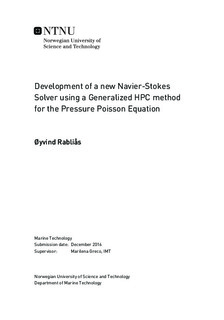| dc.description.abstract | The computational cost of solving the Navier-Stokes equations numerically is too high for most full-scale applications, especially within the marine field. Many marine structures are defined as large volume structures. For these structures give potential flow theory reliable results, to an acceptable computational cost.
Shao and Faltinsen (2012) have developed the HPC method, an efficient and accurate field solver for potential flow problems. The method utilises harmonic polynomials, which satisfy the Laplace equation by definition. Bardazzi et al. (2015) have generalized the method to solve the Poisson equation.
In this thesis is an immersed boundary grid, proposed by Hanssen et al. (2015), implemented for a circular cylinder. The potential flow around the cylinder is solved with the HPC method. A convergence rate of 3.47 was obtained for the L2 − error. However, some oscillations were observed, which is typical for im- mersed boundary methods.
The generalized HPC method is implemented in a Navier-Stokes solver, to solve the pressure Poisson equation. A uniform flow around a square cylinder is inves- tigated for a Reynolds number of 40. The results are compared with reference values. The same problem is also solved when a finite difference (FDM) scheme is used for the pressure Poisson equation.
A drag coefficient of 1.69 was obtained with the generalized HPC method, while the FDM scheme obtained a drag coefficient of 1.77. The drag coefficients in the literature are in the range between 1.6 and 1.8. None of the methods con- verged. This is probably because the finest grid was too coarse to obtain conver- gence. A uniform grid was applied, and further grid refinement was out of reach.
Concerning computational time was the generalized HPC method significant faster than the FDM scheme. For the finest grid, which corresponds to 237 600 unknowns, was the HPC solver 3.4 times faster than the FDM scheme. On the machine that was used, do this correspond to a difference of approximately 49 hours, when 30 seconds are simulated. This illustrates the potential for reducing the computational time in a Navier-Stokes solver, by using a generalized HPC method for the pressure Poisson equation.
The generalized HPC method did not automatically satisfy the discrete com- patibility condition. To resolve this was a modified equation system solved. A singular value decomposition was necessary to obtain the modified equation. This represents an additional computational cost, which should be possible to avoid. | |

